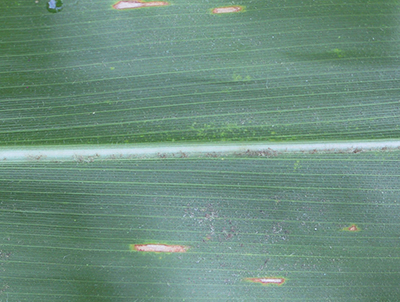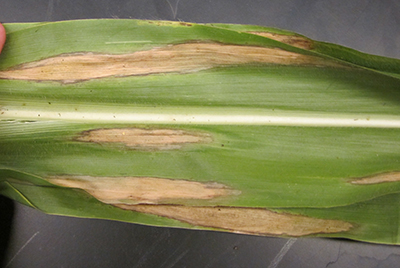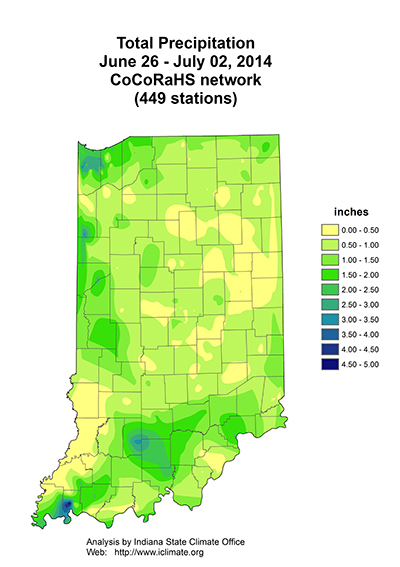USDA-NIFA Extension IPM Grant
Pest & Crop Newsletter, Entomology Extension, Purdue University
Western Corn Rootworm Beetles Emerging - (Christian Krupke and Larry Bledsoe)
• Western rootworm adults have been spotted in west central Indiana.
• Beetles should not be a concern until fields are pollinating, if at all.
• Late planted/replanted fields could be a “trap crop” for beetles and egg laying.
Western corn rootworm beetles were first observed in Tippecanoe County on June 30, captured in pheromone baited sticky cards. The male beetles are generally first to emerge and hang out, feed, and wait for 7-10 days until females begin emerging. Females generally mate upon emergence, then feed and disperse, sometimes over long distances.
After emerging, beetles will begin to feed on corn leaves if pollen is not available. Leaf feeding damage is of no economic importance. However, pollinating plants with high beetle populations could suffer economic losses from the beetles clipping silks prior to the completion of pollination. Pest managers should closely watch their fields for this type of feeding activity when pollination begins. We have not seen high populations in Indiana for at least 4-5 years, but it’s still worth keeping an eye out. Now is the time to look for lodging in fields, especially following rains and wind. Pull, or dig (preferable) some suspicious plants and look for root damage. Rootworm is the only insect to cause root damage at this time of year. Rootworm damage to Bt corn is of special interest and should be noted and reported, as resistance to Bt traited corn has been reported in several states, including IL and MI, in the last several years.
Emergence will continue over several weeks, and adult beetles will survive until late summer. They are consistently attracted to pollen sources throughout their lifespan. Therefore, late-planted fields are particularly susceptible to silk-clipping. Fields with uneven growth and/or replanting may be more vulnerable than most. These delayed areas should be closely watched for silk clipping. For additional information on rootworm beetles and their control, see Extension Publication E-219-W, Corn Insect Control Recommendations - 2014, which can be viewed at <http://extension.entm.purdue.edu/publications/E-219.pdf>.
Western corn rootworm beetle emerging from the soil
![]()
Corn Borer Surprises Some, Treatment Window Closing - (John Obermeyer and Christian Krupke)
• European corn borer infestation only a concern in non-Bt corn.
• Some highly infested fields found too late.
• Before applying a control, determine if control is possible and/or economical.
First generation European corn borer appears to be causing only minor damage to non-Bt corn (Bt corn is still holding strong against this pest). However, calls this week from southern Indiana indicate that there are some highly infested fields. It is too late for control however, since the borers are burrowed into stalks and therefore are no longer accessible/treatable in this region.
Soon, borers will be entering corn stalks throughout the state. As noted above, once in the stalk or tassel, the borer is protected from insecticides and control efficiency drops dramatically, to the point that is scarcely worth attempting. Therefore, pest managers should closely examine stalks for borer entry before making control decisions. If treatment is necessary, it is recommended that the control material be applied before 1/3 of the borers have entered the stalk. Mid-vein leaf feeding indicates that stalk tunneling is soon to begin; frass accumulation in a leaf axil signals that the stalk has been entered by a borer. That borer has had the last laugh and will pupate in the stalk and emerge later in the year to reproduce.
Corn borer in stalk is impervious to insecticides
![]()
Click here to see the 2014 Corn Earworm Trap Report
![]()
Western Bean Cutworm Adult Pheromone Trap Report
![]()
Managing White Mold in Soybean – (Kiersten Wise, Extension Specialist for Field Crop Diseases, Purdue University, Damon Smith, Extension Field Crops Pathologist, University of Wisconsin, Martin Chilvers, Extension Field Crops Pathologist, Michigan State University, Carl Bradley, Extension Plant Pathologist, University of Illinois, and Daren Mueller, Extension Plant Pathologist, Iowa State University)
Farmers in the Great Lakes area of the U.S. may be concerned about white mold (also called Sclerotinia stem rot) in soybean this year. The disease, caused by the fungus Sclerotinia sclerotiorum, is not common every year in in the Great Lakes region, but farmers that have battled the disease in the past will want to assess the risk of white mold development as soybeans approach flowering (growth stage R1 – plants have at least one open flower at any node).
White mold development is favored by cool, cloudy, wet, humid weather at flowering. The disease is more problematic in soybeans in high-yield environments where high plant populations, narrow row spacing, and an early-closing canopy are commonly used. No single management strategy is 100% effective at eliminating white mold, and in-season options for at-risk fields are limited.
There are fungicides available for in-season management of white mold, however not all commonly used fungicides are labeled for use against white mold in soybean. For information on which fungicides are labeled for disease control and recommendations on fungicide efficacy, please access the following table: <http://www.extension.purdue.edu/extmedia/BP/BP-161-W.pdf>. Fungicide recommendations are developed by the NCERA-137 national soybean disease committee, and recommendations are based on replicated research data collected from University trials.
Several products have been rated as ‘good’ for white mold management, including Aproach, Endura, and Proline. If using fungicides for white mold management, keep in mind that efficacy may be based on the ability of the fungicide to penetrate into the canopy, and the timing of the fungicide application. Fungicides will be most effective at reducing the impact of white mold when applied at or close to growth stage R1. Wisconsin research data indicates that fungicides applied up to growth stage R3 (early pod – pods are 3/16-inch long at one of the four uppermost nodes) may be effective, but later applications will likely not be effective at reducing disease. Once symptoms of white mold are evident, fungicides will have no effect on reducing the disease. Fungicide applications for white mold management may be most useful on fields where varieties rated as susceptible to white mold are planted in a field with a history of the disease.
If a soybean field is diagnosed with high levels of white mold, this field should be harvested last. This will help reduce the movement of the survival structures of the white mold fungus by harvesting equipment, to fields that are not infested. Also, be sure to clean all harvesting equipment thoroughly at the end of the season to avoid inadvertent infestation of fields. Rotations of 2-3 years between soybean crops can help reduce the level of the fungus causing white mold in fields. Using corn or small grains crops such as wheat, barley, or oats in rotation with soybean is recommended.
There are several resources available to help farmers and agribusiness personnel manage white mold. Extension plant pathologists across the North Central Region have developed a publication in collaboration with the North Central Soybean Research Program to describe the disease and optimal management strategies. This publication, titled, “Management of White Mold in Soybean” is available at the following site: <http://www.soybeanresearchinfo.com/pdf_docs/WhiteMold_NCSRP.pdf>.
This group also developed a podcast series to facilitate learning about white mold on-the-go. This series can be accessed at this site: <https://itunes.apple.com/us/podcast/management-white-mold-in-soybeans/id545266741>.
![]()
Assessing Foliar Disease Risk in Corn – (Kiersten Wise)
Much of Indiana has experienced rainy and humid weather over the past few weeks. Fields in many areas are now at or approaching tasseling, and we are receiving questions about the risk for foliar disease development and the potential need for fungicide application in corn.
Gray leaf spot (Figure 1) is appearing in the lower canopy of susceptible hybrids across Indiana, and northern corn leaf blight (Figure 2) has also been observed at low levels in northern Indiana. Many fields across Indiana are currently at a younger growth stage than normal due to delayed planting, and therefore may be at greater risk for yield loss due to disease development.
Fungicides are available to manage foliar diseases such as gray leaf spot and northern corn leaf blight. Research in Indiana indicates that fungicides are most effective at preventing yield loss due to disease when applied at the tasseling to early silking (VT-R1) growth stage. Scouting fields around V14, or just prior to tassel emergence, can help determine the level of disease pressure in a field.
Figure 1. Early symptoms of gray leaf spot on corn.
Figure 2. Elliptical lesions characteristic of Northern corn leaf blight
Recommendations for in-season management of gray leaf spot:
Iowa State University developed guidelines to determine when a fungicide may be necessary to prevent yield loss from gray leaf spot. These thresholds incorporate hybrid susceptibility ratings to gray leaf spot and disease levels prior to tasseling:
1. Consider a fungicide application if:
The hybrid is rated as susceptible or moderately susceptible AND 50 percent of the plants in a field have disease lesions present on the third leaf below the ear leaf or higher prior to tasseling. Please see the following video for identifying the area on the plant to scout for disease threshold decision-making: <http://www.youtube.com/watch?v=OCpwhvw9W_Y&feature=c4-overview-vl&list=PL1DCC2F39021955FF>
2. Consider a fungicide application if:
The hybrid is rated as moderately resistant AND 50 percent of the plants in a field have disease lesions present on the third leaf below the ear leaf or higher prior to tasseling AND additional factors or conditions that favor disease development are present (residue present, favorable weather conditions)
Scout resistant hybrids for disease problems, but in general, fungicide applications to resistant hybrids are not recommended and will not consistently result in increased yield. For more information on gray leaf spot, please read Purdue Extension bulletin BP-056-W: <http://www.extension.purdue.edu/extmedia/bp/BP-56-W.pdf>.
Recommendations for in-season management of northern corn leaf blight:
Currently we do not have thresholds available for determining when fungicide applications are needed for northern corn leaf blight, but we follow similar guidelines as gray leaf spot, in that fungicides will typically be more beneficial when applied to susceptible hybrids in high-risk fields for disease development, such as those that are in minimum or no-till. For fungicide recommendations, please see the updated fungicide efficacy table for management of corn diseases, which is developed by the national Corn Disease Working Group: <http://www.extension.purdue.edu/extmedia/BP/BP-160-W.pdf>. For more information on northern corn leaf blight, please read Purdue Extension bulletin BP-084-W: <http://www.extension.purdue.edu/extmedia/BP/BP-84-W.pdf>.
Before deciding on an in-season management strategy, keep this in mind:
The thresholds and recommendations available for in-season management decisions for any disease are not hard and fast rules. It is important to remember that disease severity can be unpredictable in Indiana, even when factors favoring disease are present. Before deciding on in-season management of any foliar disease, consider threshold guidelines, cropping practices, planting date, predicted weather conditions and economic factors, and manage expectations for what type of yield response a in-season fungicide/bactericide application will provide.
![]()
Damage to Corn Plants by Strong Winds – (Bob Nielsen) -
Storms packing strong winds have rolled through Indiana several time already this growing season. Recent storms, in particular, caused quite a bit of damage to the corn crop in some fields. The damage includes minor leaning or bending of plants, outright uprooting of plants (root lodging), and the so-called “green snap” phenomenon where stalks literally break off or snap above a stalk node (often below the harvestable ear).
The crop is particularly vulnerable to such damage from strong winds when it is in the latter stages of the rapid growth phase prior to pollination, wherein overall plant and root dry matter increases rapidly but more importantly, stalk internode elongation occurs very rapidly. Rapid elongation of the stalk internodes (the tissue between the stalk nodes or “joints”) often outpaces the lignification of the same tissue. The development of lignins provide the structural strength to the stalk.
Simple leaning of plants caused by strong winds
Root-lodged corn with range of severity for root damage
Green snap in corn caused by strong winds
Assessing the damage and predicting the eventual effect on grain yield from such damage can be challenging. The one certain advice that can be given is that such assessment should not be done the day after the storm. Rather, you should wait at least 4 to 5 days to allow the damaged plants to demonstrate whether or not they will recover.
• Simple leaning or bending of plants caused by strong winds represents the least of the damage. Such plants should recover most, if not all, of their uprightness AND if this recovery occurs prior to pollination, there should be little effect on the success of pollination. However, if the damage occurred near the onset of pollen shed and silking, then there may be some “shading” of the exposed silks (relative to pollen capture) by the leaves and stalks of neighboring lodged plants and pollination may not occur successfully.
• Plants that are root-lodged often recover by “goose necking” or gradually returning to uprightness, as demonstrated two years when similar strong storms caused wide areas of uprooted plants (Nielsen, 2011a, 2011b). Much like the assessment of plants that are simply leaning from wind, if the “goose necking” of root-lodged plants does not occur before the onset of pollen shed and silking, then there may be some “shading” of the exposed silks by the leaves and stalks of neighboring lodged plants and pollination may not occur successfully.
• The likelihood that “green snapped” plants will recover is obviously low. Plants snapped off below the harvestable ear clearly represent direct loss of yield potential, but plants snapped off above the harvestable ear may yet produce grain, albeit less than desired. Because such reduction in harvestable plant population occurs so “late in the game”, there is less opportunity for compensation by neighboring plants and so the estimated yield loss will be approximately equal to the percent of green-snapped plants.
Related Reading
Butzen, Steve. Brittle Snap Injury in Corn. DuPont Pioneer. [online] <https://www.pioneer.com/home/site/us/agronomy/library/brittle-snap/> [URL accessed July 2013].
Nielsen, RL (Bob). 2011a. An Example of “Recovery” From Severe Root-Lodging. Corny News Network, Purdue Extension. [online] <http://www.kingcorn.org/news/articles.11/FlatCorn-0728.html> [URL accessed July 2013].
Nielsen, RL (Bob). 2011b. Prospects of Recovery for Root-Lodged Corn. Corny News Network, Purdue Extension. [online] <http://www.kingcorn.org/news/articles.11/FlatCorn-0726.html> [URL accessed July 2013].
Thomison, Peter. 2011. Green Snap” Damage to Corn. Ohio State Extension C.O.R.N. [online] <http://corn.osu.edu/newsletters/2011/2011-23/201cgreen-snap-damage-to-corn> [URL accessed July 2013].
![]()










